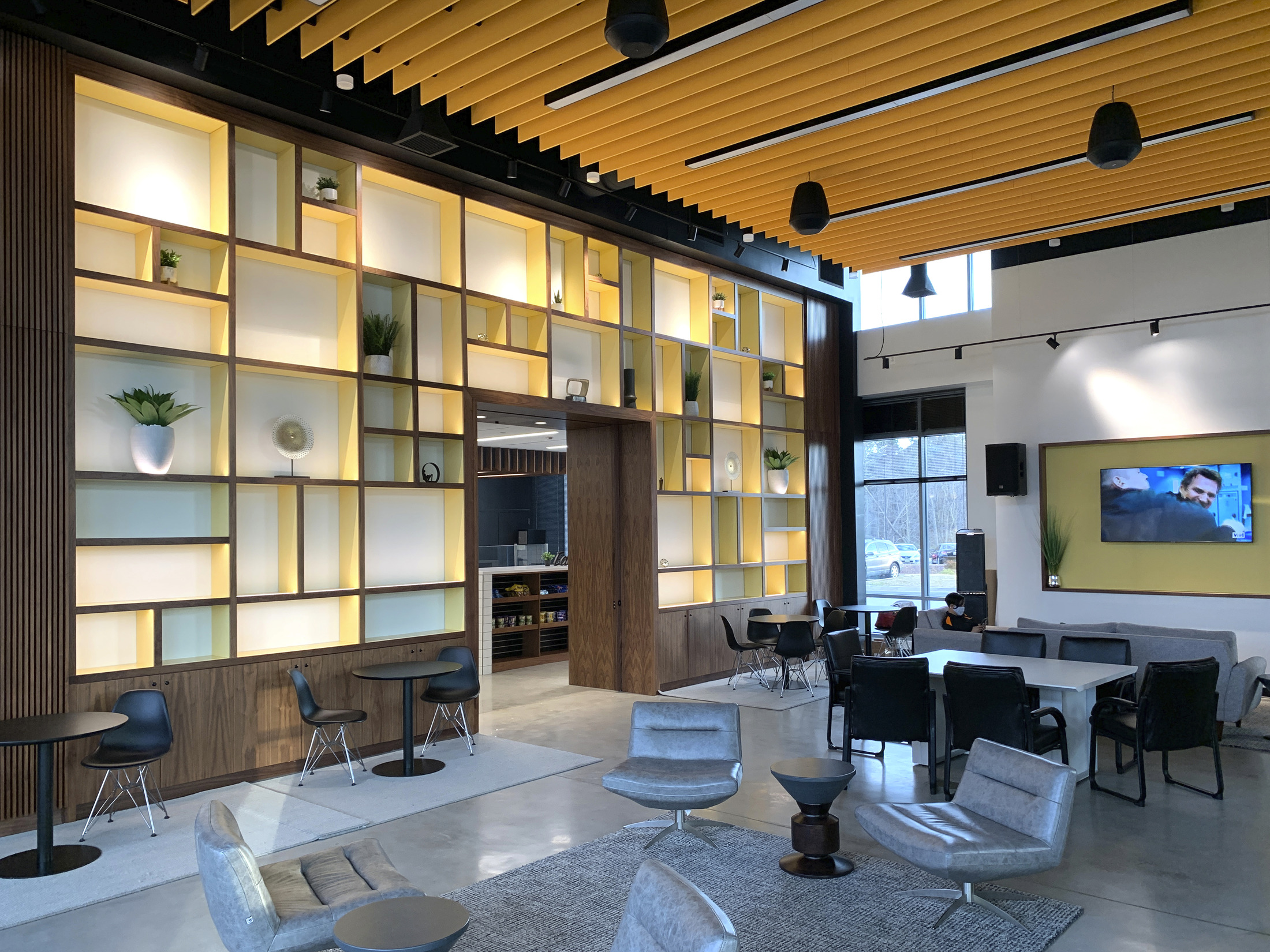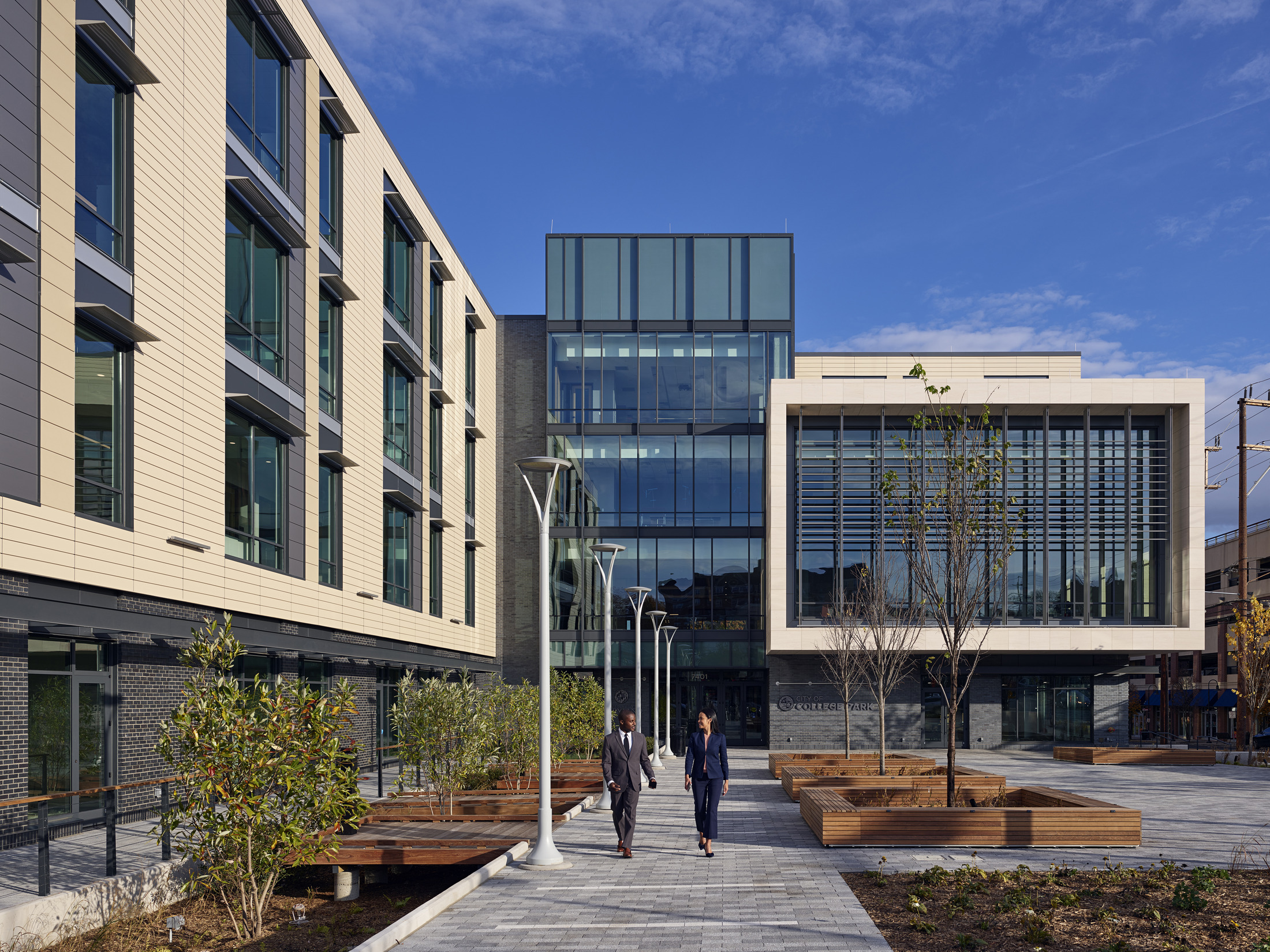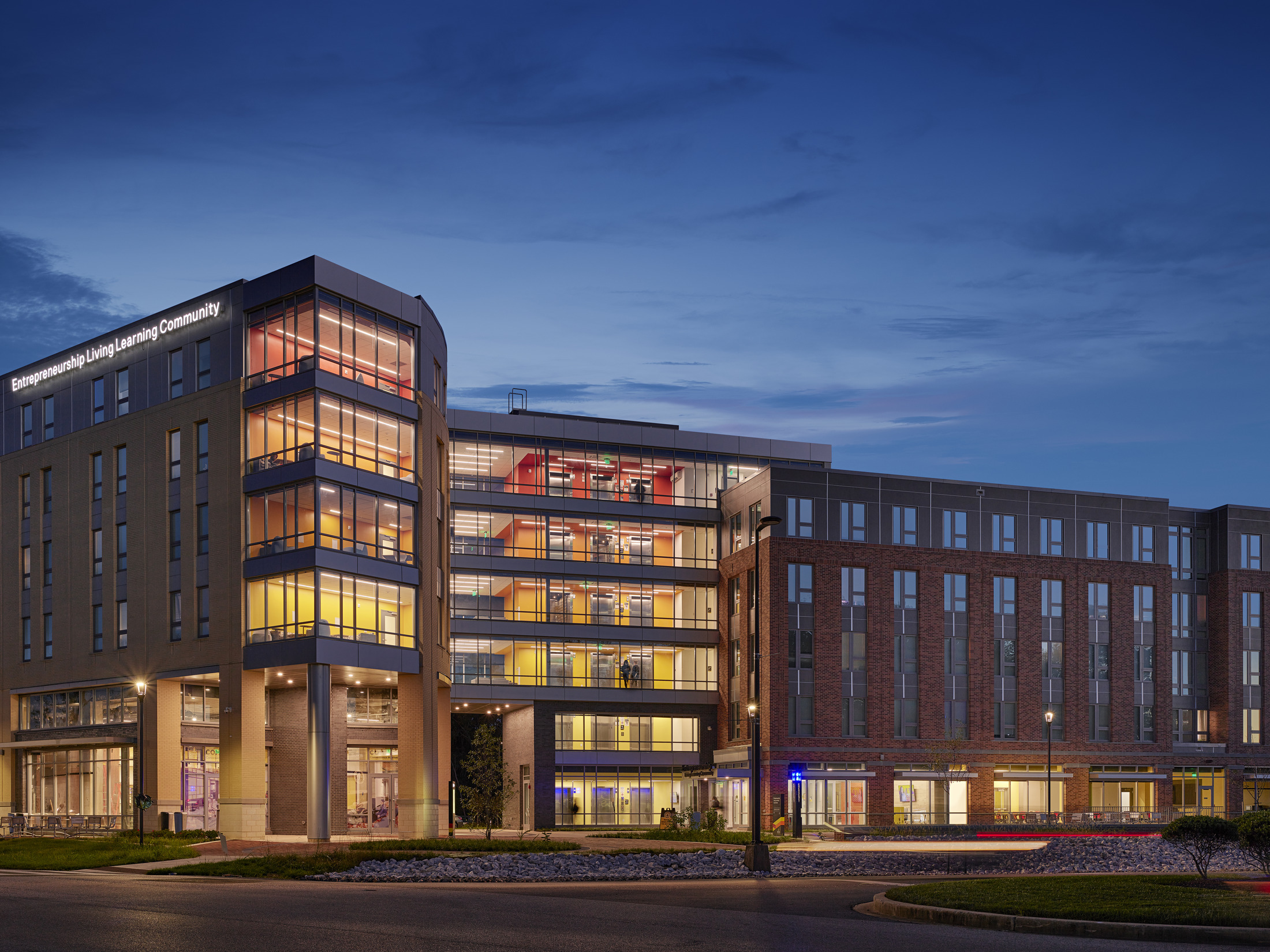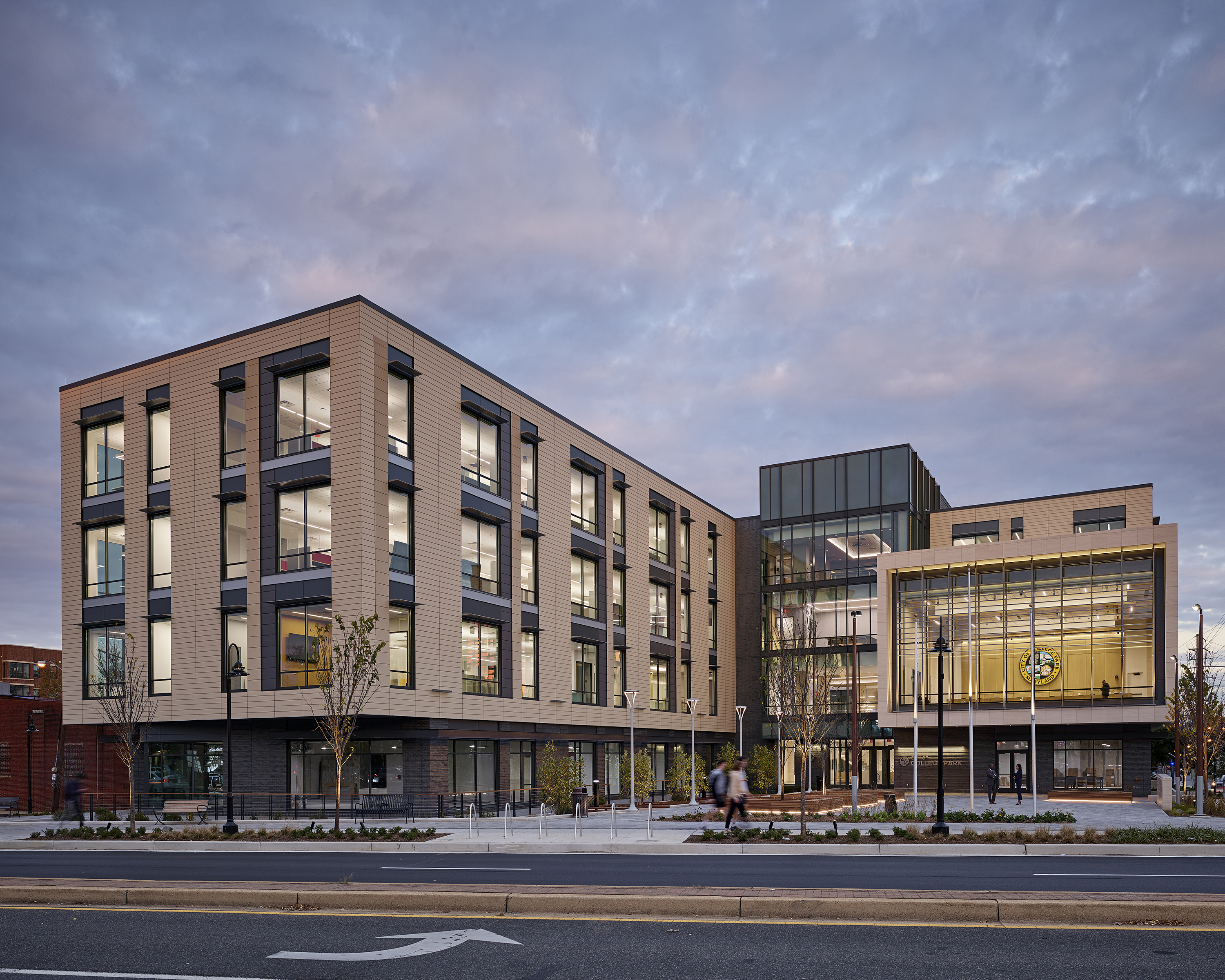
It took $51 million, years of discussions and an unconventional plan, but the grand opening of the new College Park City Hall in December demonstrated how public-private partnerships can deliver ambitious developments and help reshape communities.
Simply replacing the 60-year-old hall with another government structure could have left a prime, urban site supporting only a small, fairly stagnant building. So representatives of the city, the University of Maryland, College Park and Terrapin Development Company began exploring options to make greater use of the land.
They decided to create a larger building to house offices for both the city and university and “also realized they wanted to create a new city center, a plaza that would be open to everyone, could host events and serve as a welcoming entrance to the building,” said Scott Vieth, Principal at Design Collective.
To activate that plaza, the new building would need ground-level retail – an initiative that Terrapin Development could execute. Consequently, Design Collective presented a plan for a government-academic-retail building that would operate as a three-owner business condominium. The plan was deemed an inspired solution and a legal headache.
“I guess I got complimented and blamed all at the same time,” Vieth said. “But by bringing those three partners together, you created instant energy on that site. The project would not have been as good if they weren’t all involved.”
Public-private partnerships (P3s), by their nature, are unconventional, highly customized and challenging to execute. But they also have the potential to deliver inspired and impactful developments, create attractive opportunities for private developers and investors, lessen the financial needs of public institutions, and complete projects on tighter schedules and within contained costs.

The new Entrepreneurship Living Learning Community (ELLC) at Bowie State University includes housing for more than 500 students, technology-infused classrooms, a fitness center, lounges, study spaces, retail spaces and resources for entrepreneurs.
Ken Ulman, President of Terrapin Development Company, points to College Park as a prime example of the potential of P3s.
Terrapin was formed five years ago by UMD College Park and University of Maryland College Park Foundation “with a mission to transform College Park and the surrounding community into a great university town – a walkable, diverse, vibrant place that helps attract and retain the best faculty, staff and students and also creates jobs and helps startup companies thrive,” Ulman said. “We have over $2 billion of projects that are either recently completed, under construction or about to break ground. That doesn’t happen without a lot of partnerships. Under the radar, we have created a really thriving place and there is a lot more to come.”
P3 projects completed around College Park include city hall, a $180-million hotel/conference center, more than 400,000 square feet of Class A office space, 160,000 square feet of flex/industrial space, student housing, and other residential and mixed-use developments.
For each project, Terrapin partnered with a best-in-class private developer to determine how to execute its vision.
“We look for really good, really strong, really flexible partners because this stuff is hard. If it wasn’t hard, somebody would have done it a long time ago,” Ulman said. “There is always a wrinkle. There are always challenges. Every project almost died three times. That’s the nature of the business.”
“You have to have the patience and sometimes the stomach to see these projects through,” said Dean Lopez, Senior Vice President, Development and Construction at Corporate Office Properties Trust (COPT) However, “the pleasant and fortuitous aspect of these projects is seeing something that was a blank canvas and a vision evolve into a really vibrant opportunity and community. It’s really a thrill.”
COPT has completed four Class A office buildings totaling 425,000 square feet as part of the College Park Initiative and is in the planning phase for three more buildings, totaling 500,000 additional square feet. The development – which began with 65 acres of under-utilized, mostly industrial land with very few amenities – presented developers with bigger leasing challenges initially. However, the university, Terrapin and their private partners attracted numerous amenities.
“That has really been a game changer,” said Lopez, who has been involved with P3 projects with UMD for the last 12 years. “It puts shops, restaurants, grocery stores and residential within a half mile to a mile of some of our developments in the [UMD] Discovery District. That is attracting more interest and the velocity of development has picked up considerably.”
The university, Lopez added, has also aided the success of the overall development by trusting the expertise of its private partners. “They have trusted our judgement about the right product to develop and at what time for the market. These tend to be long-term, multi-year, multi-phase undertakings so they require both partners to be nimble, to flex with what the market needs and to be patient through the troughs.”
That ability to trust partners’ expertise and shift plans to match market conditions is just one of the skills that participants in P3 projects have been mastering.
To date, Gilbane has participated in more than 40 P3 projects, valued at over $3.5 billion. Five years ago, the company created a dedicated P3 group to enhance services to those clients.
“What P3 clients need from their builder and real estate specialist is solutions to unique project needs,” said Paul Choquette III, Regional President, P3 Practice Leader of Gilbane Building Company.
By combining the services for Gilbane’s construction and development companies in the P3 practice, “we bring our full vertical integration and the full depth of Gilbane’s abilities to help clients navigate their long-term real estate needs.”
Each project, however, presents unique challenges.
“P3s are like snowflakes. There is not one that looks exactly like another and your role will likely be different on the next one and the next one after that,” Choquette said.
P3 partners also have to wisely assess and allocate risks for each project.
“The public sector has to understand what are appropriate and reasonable risks for the private sector to take on. The private sector has to understand that a project that doesn’t succeed creates consequences for the public partner that are as great if not greater than any negative financial consequences to private partners,” said Darin Early, Managing Director of Public Private Partnerships at Gilbane Development Company.
Despite those challenges, public entities are realizing that P3s can be used for more than building schools or roads. They can be tools to advance institutional goals, expand services, drive economic development and reshape communities.

In College Park, a P3 venture combined the development of a new city hall, university office space, retail space and a civic plaza on a prime site.
“We are starting to see more P3 projects with more complex pieces,” Vieth said. “It might be one building or multiple buildings to create an innovation district or another economic development hub. It might be a university building that combines residential, academic and medical space.”
Like UMD College Park, Bowie State University embarked on a P3 project to simultaneously improve its facilities and services, and spur nearby development. The new Entrepreneurship Living Learning Community (ELLC) includes housing for more than 500 students, technology-infused classrooms, a fitness center, lounges, study spaces, retail spaces and resources for entrepreneurs, including the BSU Entrepreneurship Academy and the Bowie Business Innovation Center. Set at the entrance to campus, the ELLC also creates a ‘front door’ to Bowie State and gives the university greater visibility in the community.
“This was a great way for the university to leverage what they own – the property – to realize multiple benefits,” said Tom Zeigenfuss, Principal at Design Collective. “Providing new student housing and the entrepreneurship center gets kids excited and elevates Bowie’s ability to recruit students. The center creates a pathway for students to connect with local businesses and gain professional experience while they are in school. It is also visible from the MARC Station and raises the possibility of spurring development on both sides of the tracks.

An award-winning P3 venture at Bowie State University created a signature building that provides new student housing, academic space, retail space, amenities and an entrepreneurship center designed to aid both students and local businesses.
At the end of June, Anne Arundel County embarked on a P3 venture to spur the revitalization of Glen Burnie Town Center. Following an RFP process, the county selected a developer to transform 7409 Baltimore-Annapolis Boulevard – a piece of county-owned land that was under-utilized and contributing to blight.
“This redevelopment will result in a mixed-use development that will build on the vision of the Glen Burnie Revitalization Task Force. The project will include a mixture of apartments, townhomes, lofts and commercial office space. In addition, it will improve the environmental impact of the property by implementing stormwater management practices which will improve the health of the adjacent Saw Mill Creek,” said Wes MacQuilliam, Vice President, Business Development and Real Estate for Anne Arundel Economic Development Corporation. “A P3 is a great option for this project because the county is not equipped to handle a large redevelopment of this size. A P3 can be a great tool for redevelopment and to transform under-utilized properties into their highest and best use. Revitalizing and reinvesting in targeted growth areas will bring new businesses to the county and will further increase the tax base.”
